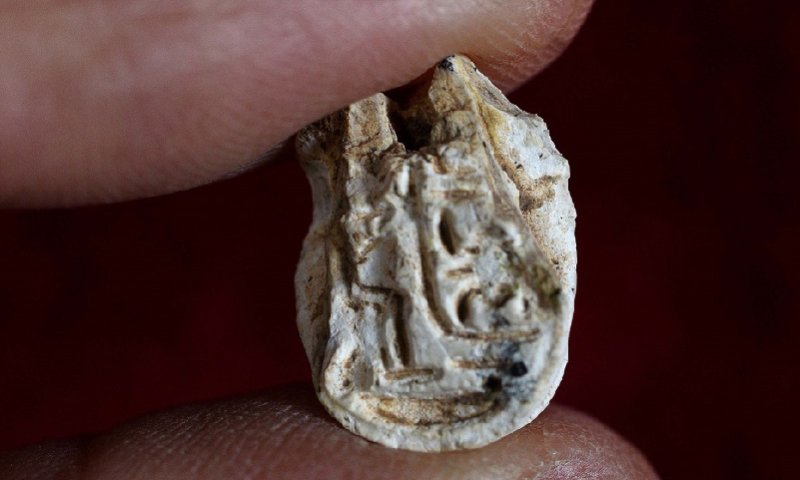
Hiker found Egyptian seal 3,500 years old
Israel Antiquities Authority gave the finder a certificate of appreciation for the discovery, which adds information about the history of the site in ancient times
- Eli Schlesinger
- כ"ד שבט התשע"ו

Photo: Clara Amit, Israel Antiquities Authority
During a trip with small children on Mount Karnei Hittin in the Lower Galilee, Amit Haklai, resident of Kfar Chittin, picked up a tiny white object which caught his eye among the black basalt stones.
Amit spotted a carved beetle-shaped object, decorated and engraved, and recognized that this is an ancient Egyptian seal. He quickly called the Antiquities Authority gave over the seal. In return, he asked only to know what is engraved on the seal, and what can be learned from the site.
The seal was identified by Dr. Daphna Ben-Tor, a curator of Ancient Egypt at the Israel Museum, as a scarab - an amulet from the New Kingdom period in Egypt. According to Ben-Tor, "the scarab shows the King Pharaoh Thutmose III seated on the throne, and before him a shredding – a round form containing icons that represent his name in hieroglyphics. Thutmose ruled for many years throughout the 15th century BC, and in his days Egypt established a ministerial-governmental array in Canaan. There, he held many conquering tours, of which the most famous was the Battle of Megiddo in the Jezreel Valley – a victory recorded on huge bas-reliefs on the walls of the Karnakh temple in Egypt".
"The scarabs," says Ben-Tor, "were carved in the form of a dung beetle – a creature with cosmological significance in ancient Egypt. In Israel many scarabs were found in archaeological excavations, and along with other artifacts of Egyptian origin, they are a testimony to the cultural, economic and political influence of Egypt in Canaan during the Late Bronze Age."
Karnei Hittin is an extinct volcano with two peaks that resemble horns, hence the name (karnei). The site is famous following the Battle of Hittin in 1187, in which Salah-al-Din, the ruler of the Ayubid dynasty in Damascus, defeated the armies of Christian Franks, and thus brought to an end the first Crusader kingdom. Many years before, during the Late Bronze Age, a fortified castle stood on the hill, probably destroyed in the 13th century BC.
According to archaeologist Yardena Alexandre of the Israel Antiquities Authority, "despite the fact that the scarab was found on the surface rather than in an archaeological excavation, it seems to be associated with the period of existence of the fort."
When Amit, with a sharp eye, received a certificate of appreciation from the IAA for good citizenship, he noted that "I would like my children to be educated with a deep connection to the Land of Israel and the antiquities of our country."
According to Dr. Miki Saban, Director of National Treasures at the Israel Antiquities Authority, "it is extremely important that citizens who are land lovers, hiking in various sites, and occasionally encounter on the ground ancient artifacts, transfer them to the Antiquities Authority. Findings find a place of honor in the State Treasury, enrich the archaeological knowledge about the country and the national collection of ancient land of Israel, and often reach exhibitions so that the public gets to enjoy them all."
Amit spotted a carved beetle-shaped object, decorated and engraved, and recognized that this is an ancient Egyptian seal. He quickly called the Antiquities Authority gave over the seal. In return, he asked only to know what is engraved on the seal, and what can be learned from the site.
The seal was identified by Dr. Daphna Ben-Tor, a curator of Ancient Egypt at the Israel Museum, as a scarab - an amulet from the New Kingdom period in Egypt. According to Ben-Tor, "the scarab shows the King Pharaoh Thutmose III seated on the throne, and before him a shredding – a round form containing icons that represent his name in hieroglyphics. Thutmose ruled for many years throughout the 15th century BC, and in his days Egypt established a ministerial-governmental array in Canaan. There, he held many conquering tours, of which the most famous was the Battle of Megiddo in the Jezreel Valley – a victory recorded on huge bas-reliefs on the walls of the Karnakh temple in Egypt".
"The scarabs," says Ben-Tor, "were carved in the form of a dung beetle – a creature with cosmological significance in ancient Egypt. In Israel many scarabs were found in archaeological excavations, and along with other artifacts of Egyptian origin, they are a testimony to the cultural, economic and political influence of Egypt in Canaan during the Late Bronze Age."
Karnei Hittin is an extinct volcano with two peaks that resemble horns, hence the name (karnei). The site is famous following the Battle of Hittin in 1187, in which Salah-al-Din, the ruler of the Ayubid dynasty in Damascus, defeated the armies of Christian Franks, and thus brought to an end the first Crusader kingdom. Many years before, during the Late Bronze Age, a fortified castle stood on the hill, probably destroyed in the 13th century BC.
According to archaeologist Yardena Alexandre of the Israel Antiquities Authority, "despite the fact that the scarab was found on the surface rather than in an archaeological excavation, it seems to be associated with the period of existence of the fort."
When Amit, with a sharp eye, received a certificate of appreciation from the IAA for good citizenship, he noted that "I would like my children to be educated with a deep connection to the Land of Israel and the antiquities of our country."
According to Dr. Miki Saban, Director of National Treasures at the Israel Antiquities Authority, "it is extremely important that citizens who are land lovers, hiking in various sites, and occasionally encounter on the ground ancient artifacts, transfer them to the Antiquities Authority. Findings find a place of honor in the State Treasury, enrich the archaeological knowledge about the country and the national collection of ancient land of Israel, and often reach exhibitions so that the public gets to enjoy them all."
תגובות
{{ comment.number }}.
הגב לתגובה זו
{{ comment.date_parsed }}
{{ comment.num_likes }}
{{ comment.num_dislikes }}
{{ reply.date_parsed }}
{{ reply.num_likes }}
{{ reply.num_dislikes }}



הוספת תגובה
לכתבה זו טרם התפרסמו תגובות